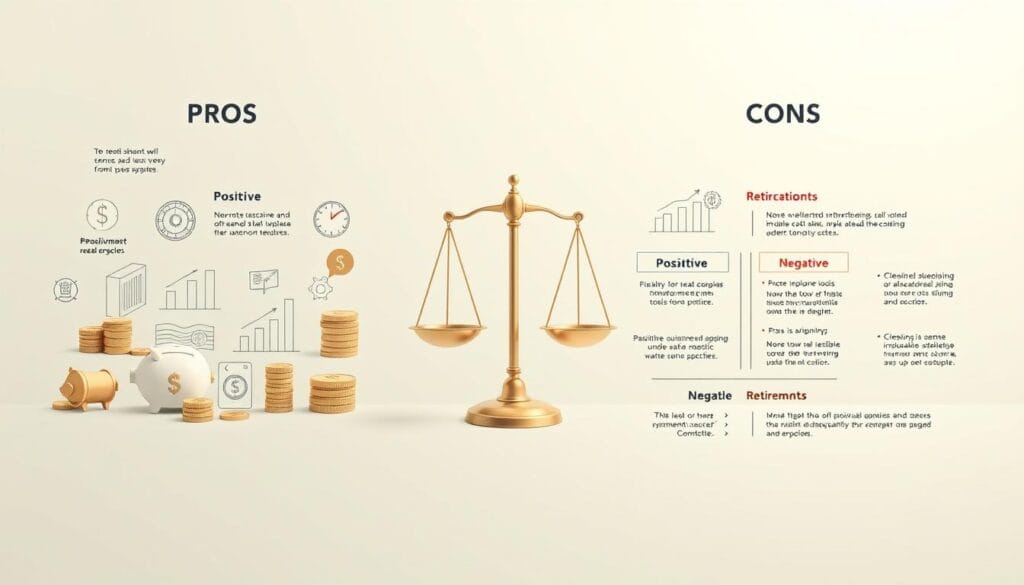Did you know that 60% of Americans fear outliving their savings due to increasing life expectancies? This growing concern highlights the importance of planning for a secure financial future. As we approach 2025, understanding how to maximize income during your later years is more critical than ever.
One solution gaining traction is annuities, which provide guaranteed payments over time. Companies like Fidelity offer competitive fees, with their Personal Retirement Annuity charging just 0.25%, significantly lower than the industry average of 1.03%. This makes them an attractive option for those seeking stability in their income streams.
With regulatory changes expected in 2025, it’s essential to stay informed about how these updates might impact annuity products. Whether you’re looking to supplement Social Security or secure a steady income, annuities can play a vital role in your financial plan. For more insights on managing your finances, check out low-fee robo-advisors.
Key Takeaways
- 60% of Americans worry about outliving their savings due to longer life expectancies.
- Fidelity’s Personal Retirement Annuity offers lower fees compared to the industry average.
- 2025 regulatory changes may influence annuity products and their benefits.
- Annuities can supplement Social Security and provide guaranteed income.
- Planning early ensures a more secure financial future.
What Are Annuities and How Do They Work?

Annuities are financial tools designed to provide steady income during later years. They are insurance contracts where you exchange a lump sum or series of payments for guaranteed income over time. This makes them a reliable option for managing financial risks in later life.
There are two main types: immediate and deferred. Immediate annuities start payouts within a year, while deferred annuities begin later, allowing your funds to grow with tax-deferred interest. This flexibility helps tailor the product to your specific needs.
Understanding the Basics of Annuities
Annuities work through a process called mortality risk pooling. Insurance companies pool funds from many individuals to provide lifetime income streams. This spreads the risk and ensures payments continue, even if you outlive your savings.
For example, NYLIAC’s irrevocable deferred income annuity restricts access to funds until payouts begin. This ensures the money is available when you need it most.
How Annuities Fit into Retirement Planning
Annuities can play a key role in securing your financial future. They offer tax-deferred growth, meaning you won’t pay taxes on earnings until you withdraw funds. However, early withdrawals may incur penalties.
By integrating annuities into your plan, you can create a stable income stream to supplement other sources like Social Security. For more insights on managing your finances, explore micro-investing platforms.
Types of Annuities: Which One is Right for You?

When planning for financial stability, understanding the different types annuities is crucial. Each type offers unique benefits and risks, making it essential to choose the one that aligns with your goals. Below, we explore the key categories to help you make an informed decision.
Fixed Annuities: Predictable and Secure
Fixed annuities provide a guaranteed return, ensuring your principal is protected. This makes them a low-risk option for those seeking stability. Unlike other types, they are not tied to the market, offering peace of mind during economic fluctuations.
Variable Annuities: Growth Potential with Risk
Variable annuities allow you to invest in the market, offering higher return potential. However, they come with increased risk, as your investment value can fluctuate. Fidelity’s VIP FundsManager 60% ties to underlying fund volatility, highlighting this exposure.
Fixed Index Annuities: A Balanced Approach
Fixed index annuities offer a middle ground, linking returns to a market index like the S&P 500. However, they often cap gains—for example, at 7% even if the index rises by 15%. This limits upside potential but provides some protection against losses.
Immediate vs. Deferred Annuities: Timing Your Income
Immediate annuities start payouts shortly after a lump sum is invested, while deferred annuities delay payments, allowing funds to grow. New York Life’s FP Series GLWB rider offers flexible terms, contrasting with standard annuity contract structures.
Understanding these types annuities ensures you select the right type for your financial needs. Always evaluate fees, surrender charges, and company stability before committing to an annuity contract.
Pros and Cons of Annuity Options for Retirement

Evaluating the strengths and weaknesses of financial products can help secure your future. These tools offer unique benefits but also come with potential drawbacks. Understanding both sides ensures you make informed decisions tailored to your needs.
Advantages of Financial Tools
One major benefit is guaranteed income, providing stability during later years. This ensures you have a steady stream of money regardless of market conditions. Additionally, some products offer tax-deferred growth, allowing your funds to increase in value over time.
Another advantage is the death benefit, which can provide financial security for your loved ones. This feature ensures that your beneficiaries receive a payout if you pass away during the contract period.
Disadvantages of Financial Tools
One significant drawback is inflation risk. Fixed products, for example, lose an average of 3.8% annually to inflation. This can erode the purchasing power of your money over time.
Another concern is the fees associated with these products. Variable options often include mortality expense ratios, which can reduce overall returns. Additionally, early withdrawals may incur penalties, such as Fidelity’s 10% IRS penalty for pre-59½ withdrawals.
Lastly, some products limit access to funds during the contract period. This can restrict flexibility if you need immediate access to your money.
How to Choose the Best Annuity for Your Retirement Goals

Selecting the right financial product for your later years requires careful consideration of your unique circumstances. Whether you’re planning for stability or growth, understanding your needs and the available options is essential. This section will guide you through the key factors to consider when making this important decision.
Assessing Your Financial Needs
Start by evaluating your needs and goals. Consider how much funds you’ll require to maintain your lifestyle. Think about your desired income rate and how long you’ll need it to last. This will help you determine the right amount to invest and the type of product that aligns with your objectives.
Understanding Fees and Charges
Fees can significantly impact your overall performance. For example, Fidelity’s product charges just 0.25%, compared to the industry average of 1.03%. Be sure to compare surrender charge periods and other costs across providers. This will help you maximize your returns and avoid unnecessary expenses.
Evaluating Insurance Company Stability
The strength of the insurance company is crucial. Look for providers with high AM Best ratings, as this indicates financial stability. NYLIFE Distributors LLC, for instance, is a FINRA/SIPC member, ensuring compliance and reliability. Always research the company’s track record before committing.
By carefully assessing your needs, understanding fees, and evaluating the insurance company, you can make an informed decision. For more insights on managing your finances, explore our comprehensive solutions.
Tax Implications of Annuities
Understanding the tax implications of financial products is crucial for maximizing your income. These tools can offer significant benefits, but they also come with complex rules that can impact your overall value. Knowing how these rules apply can help you make informed decisions.
Tax-Deferred Growth
One of the key benefits is tax-deferred growth. This means you won’t pay taxes on earnings until you withdraw money. This allows your funds to grow more efficiently over the years. However, early withdrawals before age 59½ can incur a 10% IRS penalty plus ordinary income tax.
For nonqualified contracts, a 3.8% net investment tax may apply. This makes it essential to understand the differences between qualified and nonqualified contracts. Qualified contracts are typically funded with pre-tax dollars, while nonqualified contracts use after-tax funds.
Taxation of Withdrawals
When it comes to withdrawals, the tax treatment varies. The taxable portion of payments is subject to federal income tax withholding. Taxpayers can use Form W-4P to specify their withholding preferences. This ensures you manage your income effectively.
Required minimum distribution rules also play a role. These rules mandate that you start taking withdrawals by a certain age, typically 72. Failing to do so can result in penalties. For more detailed guidance, refer to IRS Publication 575.
Additionally, state variations can impact your contract. For example, New York Life contracts may have different tax treatments depending on the state. Always review your specific terms to understand how they apply to your situation.
By understanding these tax implications, you can make smarter financial decisions. For more tips on maximizing your income, explore our guide on tax-efficient strategies.
Common Mistakes to Avoid When Buying Annuities
Navigating financial products requires careful attention to avoid costly errors. Many individuals overlook critical details, leading to unexpected fees or reduced returns. Understanding these pitfalls can help you make smarter decisions and protect your investment.
Overlooking Fees and Expenses
One of the most common mistakes is ignoring the fees associated with financial products. Variable options often include administrative charges, mortality and expense risk fees, and rider costs. These can significantly reduce your overall returns.
Morningstar’s benchmarks show that variable product fees often exceed those of comparable mutual funds. Always review the fee structure and compare it with other options to ensure you’re getting the best value.
Ignoring Inflation Risks
Another critical error is failing to account for inflation. Fixed products, for example, lose an average of 3.8% annually to inflation. This can erode the purchasing power of your money over time.
Consider products that offer inflation protection or growth potential to mitigate this risk. This ensures your funds retain their value in the long term.
Failing to Read the Fine Print
Many individuals skip reading the contract details, leading to unpleasant surprises. Surrender charges, for instance, can start at 10% and decrease annually over 5 to 10 years.
New York Regulation 168 requires insurance companies to provide clear disclosures about these charges. Always review the terms and conditions to understand your obligations and benefits.
For more insights on avoiding common mistakes, explore our detailed guide.
Conclusion
Securing your financial future requires careful planning and informed decisions. With 74% of buyers regretting not comparing multiple providers, it’s essential to evaluate your options thoroughly. Key criteria include understanding fees, assessing provider stability, and aligning products with your long-term goals.
Fidelity and New York Life stand out with competitive features like low fees and flexible terms. However, consulting a third-party advisor can provide unbiased guidance, ensuring you make the best choice for your life and years ahead.
Looking ahead, the 2025 market is expected to introduce new regulatory changes, making it crucial to stay informed. For personalized assistance, consider reaching out to experts who can help you navigate these options effectively. Explore payout options to ensure your plan aligns with your needs.

